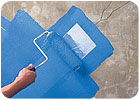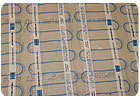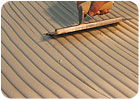
Despite continually reading about the projected downturn in new home starts, the remodeling sector appears to be maintaining its strength. In the floor covering sector, residential remodeling with natural stone has outpaced all other options in terms of annual growth rate for three consecutive years - becoming increasingly more important as distributors, contractors and dealers key in on the much larger profit margins that stone offers. As the stone sector continues to grow, builders and remodelers are being asked to install these finishes in more applications than the usual bath, kitchen backsplash or countertop. It is imperative to the stone industry that remodelers, and even new builders, are educated on the proper techniques and methods for successful installations. If this takes place, all of us grow exponentially.
Due to the increased use of stone in homes, builders have had to adjust the way that their homes and structures are designed and built beneath the stone application. Traditionally, it has been taken for granted that the structure beneath the stone areas could be the same construct that is beneath the hardwood, resilient or carpeted areas. With the increase in popularity in large-format stone and longer spans for larger rooms, failures can occur if the structures are not designed properly. Usually, builders rely on their in-house design team, architects or even the lumber and framing supply houses to provide them with the plans and designs for the construction of their homes. While this may be suitable for most of the areas that receive the common flooring types (carpet and wood), the areas that receive stone must be designed to a more rigid standard.

Structural requirements for stone installations
Before any work starts, the surface must be rigid enough to accept the stone finish. The Ceramic Tile Handbook published by the Tile Council of North America explains that it is the responsibility of the project architect or engineer to determine if the substrate meets the proper stiffness and deflection criteria. The substrate needs to be built in accord with applicable building codes for the structures intended use and meet the maximum allowable deflection for the finish and the installation system that will be installed.Deflection is the potential movement that the installation can experience when subjected to load and use. Stone requires a very rigid substrate in order to function correctly. Typically, substrates must meet the industry-standard maximum allowable deflection rating of L/720 for stone applications. Some adhesive manufacturers will allow an L/480 deflection standard for stone applications.
It is important for builders to keep in mind that these maximum allowable deflection standards are very different from the L/360 design standard that is called out in most building codes. The building code requirement applies to a uniformly applied load across the spans. This is distinctly different than the concentrated 300-pound load that is required for tile and stone substrates. An example: A person is walking over a structure with heels. This exerts a tremendous, concentrated force down to a small area. A person weighing 150 pounds concentrating his/her weight load to a small heel is distinctly different than the same 150 pounds being uniformly distributed over the span of an entire floor. Appliances that sit on “legs” or wheels will also concentrate their weight load.
Some other things to keep in mind are: What will the areas that receive the stone finish be used for? How many people will be using the area? The more people that will use an area, the more rigid the structure needs to be. A floor that is designed at a 40-pound total live and dead load may be suitable in areas for a family of four or five people. However, what if they intend to entertain a lot? Those same areas may have 20 to 30 people on the structure regularly. What may have been rigid enough for a normal-sized family is now being pushed beyond its deflection limits - and, can cause cracking grout, or even worse, cracking tiles and stones.

Proper preparation
With all stone installations, proper surface preparation is probably the most important phase of the work, but often the most overlooked. Even when it needs to be specifically addressed, not enough time or resources are generally allocated to ensure that it is done correctly. This is especially true in remodeling work. There are a few common requirements for all surface types relative to floor preparation. These are generally related to the cleanliness of the substrate (and its rigidity, as we have already discussed).All substrates must be free of any bond-breaking or bond-inhibiting materials. These may include sealers, waxes, curing compounds, form release agents, paint, dirt, grease, oils, old carpet adhesives and other contaminants. They must be completely removed prior to the commencement of the installation. One of the best ways to remove these contaminants is by mechanical abrasion. Usually, the contaminants have penetrated into the substrate’s pores and will block the adhesives’ ability to create a mechanical bond or attachment to the surface. It is not a good idea to use chemicals or acid to strip or to remove contaminants. These chemicals or acids may penetrate into the substrate and will be virtually impossible to remove.